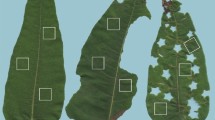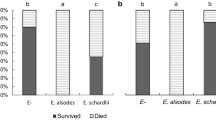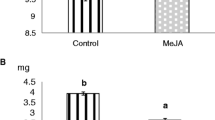Abstract
The Africa-derived ornamental geranium, Pelargonium × hortorum, is now widely planted in North America, leading to novel interactions with native herbivores such as the soybean looper, Chrysodeixis includens. Soybean looper eggs and larvae survive poorly on P. × hortorum. High mortality can be attributed specifically to glandular trichomes. Individual eggs treated with exudate from a single tall glandular trichome were significantly less likely to hatch than untreated eggs. Few early-instar larvae survived on either intact or excised leaves, but survival increased when trichome exudate was removed by rinsing leaves with ethanol or when the tall and short glandular trichomes were both plucked from the leaf surface. Surprisingly, final instar loopers often severed the veins of geranium leaves before feeding beyond the cuts, a behavior normally exhibited on plants with canal-borne exudates such as latex. To identify the cue that triggers vein cutting, loopers were tested with solutions of two known defensive compounds found in Pelargonium (l-quisqualic acid, 22:0 anacardic acid); both were inactive in eliciting vein cutting. However, exudate collected from the tall glandular trichomes triggered vein cutting, thus documenting for the first time the chemical stimulant for vein cutting in a plant species that lacks canal-borne exudates. Loopers severed leaf veins more frequently on plants previously fed upon indicating that the chemical trigger for vein cutting increases with damage. Vein cuts sever the major supply arteries in the leaf, thus potentially blocking inducible geranium responses to herbivory.








Similar content being viewed by others
References
Alexander AJ (1961) A study of the biology and behavior of the caterpillars, pupae and emerging butterflies of the subfamily Heliconiinae in Trinidad, West Indies. Part I. some aspects of larval behavior. Zoologica 46:1–25
Cox GW (2004) Alien species and evolution: the evolutionary ecology of exotic plants, animals, microbes, and interacting native species. Island Press, Washington
Dalin P, Ågren J, Björkman C, Huttunen P, Kärkkäinen K (2008) Leaf trichome formation and plant resistance to herbivory. In: Schaller A (ed) Induced plant resistance to herbivory. Springer, New York, pp 89–105
Duke SO, Canel C, Rimando AM, Tellez MR, Duke MV, Paul RN (2000) Current and potential exploitation of plant glandular trichome productivity. Adv Bot Res 31:121–151
Dussourd DE (1993) Foraging with finesse: caterpillar adaptations for circumventing plant defenses. In: Stamp NE, Casey TM (eds) Caterpillars: ecological and evolutionary constraints on foraging. Chapman and Hall, New York, pp 92–131
Dussourd DE (1997) Plant exudates trigger leaf-trenching by cabbage loopers, Trichoplusia ni (Noctuidae). Oecologia 112:362–369
Dussourd DE (2003) Chemical stimulants of leaf-trenching by cabbage loopers: natural products, neurotransmitters, insecticides, and drugs. J Chem Ecol 29:2023–2047
Dussourd DE (2009) Do canal-cutting behaviours facilitate host-range expansion by insect herbivores? Biol J Linn Soc 96:715–731
Dussourd DE, Denno RF (1991) Deactivation of plant defense: correspondence between insect behavior and secretary canal architecture. Ecology 72:1383–1396
Dussourd DE, Denno RF (1994) Host range of generalist caterpillars: trenching permits feeding on plants with secretory canals. Ecology 75:69–78
Farag M, Ahmed MH, Yousef H, El-Badawey SS, Abd El-Ghany MA, Abdel-Rahman AAH (2012) Repellent and insecticide activity of Pelargonium × hortorum against Spodoptera littoralis (Boisd.). Z Naturforsch C-J Biosci 67(7):398–404
Gerhold DL, Craig R, Mumma RO (1984) Analysis of trichome exudate from mite-resistant geraniums. J Chem Ecol 10:713–722
Graves SD, Shapiro SM (2003) Exotics as host plants of the California butterfly fauna. Biol Conserv 110:413–433
Grazzini R, Hesk D, Yerger E, Cox-Foster D, Medford J, Craig R, Mumma RO (1995a) Distribution of anacardic acids associated with small pest resistance among cultivars of Pelargonium × hortorum. J Am Soc Hortic Sci 120:343–346
Grazzini R, Hesk D, Yerger E, Cox-Foster D, Medford J, Craig R, Mumma RO (1995b) Species distribution of biochemical and morphological characters associated with small pest resistance in Pelargonium × hortorum. J Am Soc Hortic Sci 120:336–342
Green ES, Zangerl AR, Berenbaum MR (2001) Effects of phytic acid and xanthotoxin on growth and detoxification in caterpillars. J Chem Ecol 27:1763–1773
Greeney HF, Dyer LA, Smilanich AM (2012) Feeding by lepidopteran larvae is dangerous: a review of caterpillars’ chemical, physiological, morphological, and behavioral defenses against natural enemies. Invert Surviv J 9:7–34
Hare JD, Walling LL (2006) Constitutive and jasmonate-inducible traits of Datura wrightii. J Chem Ecol 32:29–47
Harman J, Paul P, Craig R, Cox-Foster D, Medford J, Mumma RO (1996) Development of a mite bioassay to evaluate plant resistance and its use in determining regeneration of spider mite resistance. Entomol Exp Appl 81:301–305
Heckel DG (2014) Insect detoxification and sequestration strategies. In: Voelckel C, Jander G (eds) Annual plant reviews, vol 47., Insect-plant interactionsWiley, Oxford, pp 77–114
Heidel-Fischer HM, Musser RO, Vogel H (2014) Plant transcriptomic responses to herbivory. Ann Plant Rev 47:155–196
Held DW, Potter DA (2003) Characterizing toxicity of Pelargonium spp. and two other reputedly toxic plant species to Japanese beetles (Coleoptera: Scarabaeidae). Environ Entomol 32:873–880
Helmus MR, Dussourd DE (2005) Glues or poisons: which triggers vein cutting by monarch caterpillars? Chemoecology 15:45–49
Hesk D, Craig R, Mumma RO (1992) Comparison of anacardic acid biosynthetic capability between insect-resistant and susceptible geraniums. J Chem Ecol 18:1349–1364
Houghton P, Lis-Balchin M (2002) Chemotaxonomy of Pelargonium based on alkaloids and essential oils. In: Lis-Balchin M (ed) Geranium and Pelargonium: the genera Geranium and Pelargonium. Taylor and Francis, New York, pp 166–173
Hurley KW (2014) Tricky trichomes: chemical defense in geranium and counteradaptations by soybean loopers. Masters dissertation, University of Central Arkansas
Jander G (2014) Revisiting plant-herbivore co-evolution in the molecular biology era. In: Voelckel C, Jander G (eds) Annual plant reviews, vol 47., Insect-plant interactionsWiley, Oxford, pp 361–384
Karban R, Agrawal AA (2002) Herbivore offense. Ann Rev Ecol Syst 33:641–664
Kelsey RG, Reynolds GW, Rodriguez E (1984) The chemistry of biologically active constituents secreted and stored in plant glandular trichomes. In: Rodriguez E, Healey PL, Mehta I (eds) Biology and chemistry of plant trichomes. Plenum Press, New York, pp 187–241
Kobayashi S, Asai T, Fujimoto Y, Kohshima S (2008) Anti-herbivore structures of Paulownia tomentosa: morphology, distribution, chemical constituents and changes during shoot and leaf development. Ann Bot 101:1035–1047
Kunz TN, Fujita MS, Brooke AP, McCracken GF (1994) Convergence in tent architecture and tent-making behavior among neotropical and paleotropical bats. J Mamm Evol 2:57–78
Lafontaine JD, Poole RW (1991) Noctuoidea: Noctuidae (part). In: Dominick RB et al. (eds) The Moths of America North of Mexico, Fascicle 25.1. Wedge Entomological Research Foundation, Washington
Laue G, Preston CA, Baldwin IT (2000) Fast track to the trichome: induction of N-acyl nornicotines precedes nicotine induction in Nicotiana repanda. Planta 210:510–514
Levin DA (1973) The role of trichomes in plant defense. Q Rev Biol 48:3–15
Lis-Balchin M (2002) Essential oils from different Pelargonium species and cultivars: their chemical composition (using GC, GC/MS) and appearance of trichomes (under EM). In: Lis-Balchin M (ed) Geranium and Pelargonium: the genera Geranium and Pelargonium. Taylor and Francis, New York, pp 147–165
Liu XC, Yang K, Wang SY, Wang XG, Liu ZL, Cheng J (2013) Composition and insecticidal activity of the essential oil of Pelargonium hortorum flowering aerial parts from China against two grain storage insects. J Med Plant Res 7:3263–3268
Metcalfe CR, Chalk L (1983) Anatomy of the dicotyledons, vol II. Clarendon Press, Oxford
Miller D (2002) The taxonomy of Pelargonium species and cultivars, their origins and growth in the wild. In: Lis-Balchin M (ed) Geranium and Pelargonium: the genera Geranium and Pelargonium. Taylor and Francis, New York, pp 49–79
Mooney HA (2005) Invasive alien species: the nature of the problem. In: Mooney HA, Mack RN, McNeely JA, Neville LE, Schei PJ, Waage JK (eds) Invasive alien species: a new synthesis. Island Press, Washington, pp 1–15
Oppel CB, Dussourd DE, Garimella U (2009) Visualizing a plant defense and insect counterploy: alkaloid distribution in Lobelia leaves trenched by a plusiine caterpillar. J Chem Ecol 35:625–634
Peiffer M, Tooker JF, Luthe DS, Felton GW (2009) Plants on early alert: glandular trichomes as sensors for insect herbivores. New Phytol 184:644–656
Ranger CM, Winter RE, Singh AP, Reding ME, Frantz JM, Locke JC, Krause CR (2011) Rare excitatory amino acid from flowers of zonal geranium responsible for paralyzing the Japanese beetle. Proc Natl Acad Sci USA 108:1217–1221
Schaller A (ed) (2008) Induced plant resistance to herbivory. Springer, New York
Schultz DJ, Medford JI, Cox-Foster D, Grazzini RA, Craig R, Mumma RO (2000) Anacardic acids in trichomes of Pelargonium: biosynthesis, molecular biology, and ecological effects. Adv Bot Res 31:175–192
Schultz DJ, Wickramasinghe NS, Klinge CM (2006) Anacardic acid biosynthesis and bioactivity. Rec Adv Phytochem 40:131–156
Simmonds MSJ (2002) Interactions between arthropod pests and pelargoniums. In: Lis-Balchin M (ed) Geranium and Pelargonium: the genera Geranium and Pelargonium. Taylor and Francis, New York, pp 291–298
Spencer KC (ed) (1988) Chemical mediation of coevolution. Academic Press, New York
Stark RS (1975) Morphological and biochemical factors relating to spider mite resistance in the geranium. Dissertation, Pennsylvania State University
Tian D, Tooker J, Peiffer M, Chung SH, Felton GW (2012) Role of trichomes in defense against herbivores: comparison of herbivore response to woolly and hairless trichome mutants in tomato (Solanum lycopersicum). Planta 236:1053–1066
Tissier A (2012) Glandular trichomes: what comes after expressed sequence tags? Plant J 70:51–68
Van Schie CCN, Haring MA, Schuurink RC (2007) Tomato linalool synthase is induced in trichomes by jasmonic acid. Plant Mol Biol 64:251–263
Wagner DL, Schweitzer DF, Sullivan JB, Reardon RC (2011) Owlet caterpillars of eastern North America. Princeton University. Press, Princeton
Wagner GJ (1991) Secreting glandular trichomes: more than just hairs. Plant Physiol 96:675–679
Walters DS, Craig R, Mumma RO (1989a) Glandular trichome exudate is the critical factor in geranium resistance to foxglove aphid. Entomol Exp Appl 53:105–109
Walters DS, Grossman H, Craig R, Mumma RO (1989b) Geranium defensive agents. IV. Chemical and morphological bases of resistance. J Chem Ecol 15:357–372
Walters DS, Craig R, Mumma RO (1990) Effects of mite resistance mechanism of geraniums on mortality and behavior of foxglove aphid (Acyrthosiphon solani). J Chem Ecol 16:877–886
Williams CA, Harborne JB (2002) Geranium and Pelargonium: phytochemistry of the genus Pelargonium. In: Lis-Balchin M (ed) Geranium and Pelargonium: the genera Geranium and Pelargonium. Taylor and Francis, New York, pp 99–115
Yu SJ (1983) Age variation in insecticide susceptibility and detoxification capability of fall armyworm (Lepidoptera: Noctuidae) larva. J Econ Entomol 76:219–222
Zalucki MP, Clarke AR, Malcolm SB (2002) Ecology and behavior of first instar larval Lepidoptera. Ann Rev Entomol 47:361–393
Zeng RS, Wen Z, Niu G, Berenbaum MR (2013) Aflatoxin B1: toxicity, bioactivation and detoxification in the polyphagous caterpillar, Trichoplusia ni. Insect Sci 20:318–328
Acknowledgments
Special thanks to Reid Adams, K.C. Larson, Jerry Manion, Rick Noyes, Christopher Ranger, and Patrick Ward for helpful advice, to Pablo Jourdan at the Ornamental Plant Germplasm Center (Ohio State University and USDA-ARS) for donating geranium cuttings, to K.C. Larson and two anonymous reviewers for thorough reviews and many helpful suggestions, and to the University of Central Arkansas (CNSM Student Research grants) and the Arkansas Center for Plant-Powered Production (P3) for funding. The P3 Center is funded through the RII: Arkansas ASSET Initiatives (AR EPSCoR) I (EPS-0701890) and II (EPS-1003970) by the National Science Foundation and the Arkansas Science and Technology Authority.
Author information
Authors and Affiliations
Corresponding author
Additional information
Handling Editor: Michael Smith.
Electronic supplementary material
Below is the link to the electronic supplementary material.
11829_2014_9348_MOESM1_ESM.tif
(A) Soybean looper egg daubed with orange exudate from a single tall glandular trichome from P. × hortorum. (B) Soybean loopers hanging immobilized after consuming geranium petals. (C) Focus stacked image of tall glandular trichomes on the abaxial surface of a geranium leaf. Orange exudate is clearly visible at the tip of the trichomes. (D) Same trichomes after the leaf was rinsed with ethanol; the orange trichome exudate has been removed. Scale bars equal 100 µm (TIFF 8489 kb)
11829_2014_9348_MOESM2_ESM.tif
(A) Focus stacked images of trichomes found on the edge of a geranium leaf: tall glandular trichomes with orange tips, short glandular trichomes with translucent tips, and nonglandular trichomes with pointed tips. (B) Leaf edge after nonglandular trichomes have been removed with fine forceps; the glandular trichomes remain. (C) Leaf edge after tall glandular trichomes have been removed; nonglandular and short glandular trichomes remain. Scale bar equals 100 µm (TIFF 19810 kb)
Rights and permissions
About this article
Cite this article
Hurley, K.W., Dussourd, D.E. Toxic geranium trichomes trigger vein cutting by soybean loopers, Chrysodeixis includens (Lepidoptera: Noctuidae). Arthropod-Plant Interactions 9, 33–43 (2015). https://doi.org/10.1007/s11829-014-9348-6
Received:
Accepted:
Published:
Issue Date:
DOI: https://doi.org/10.1007/s11829-014-9348-6




